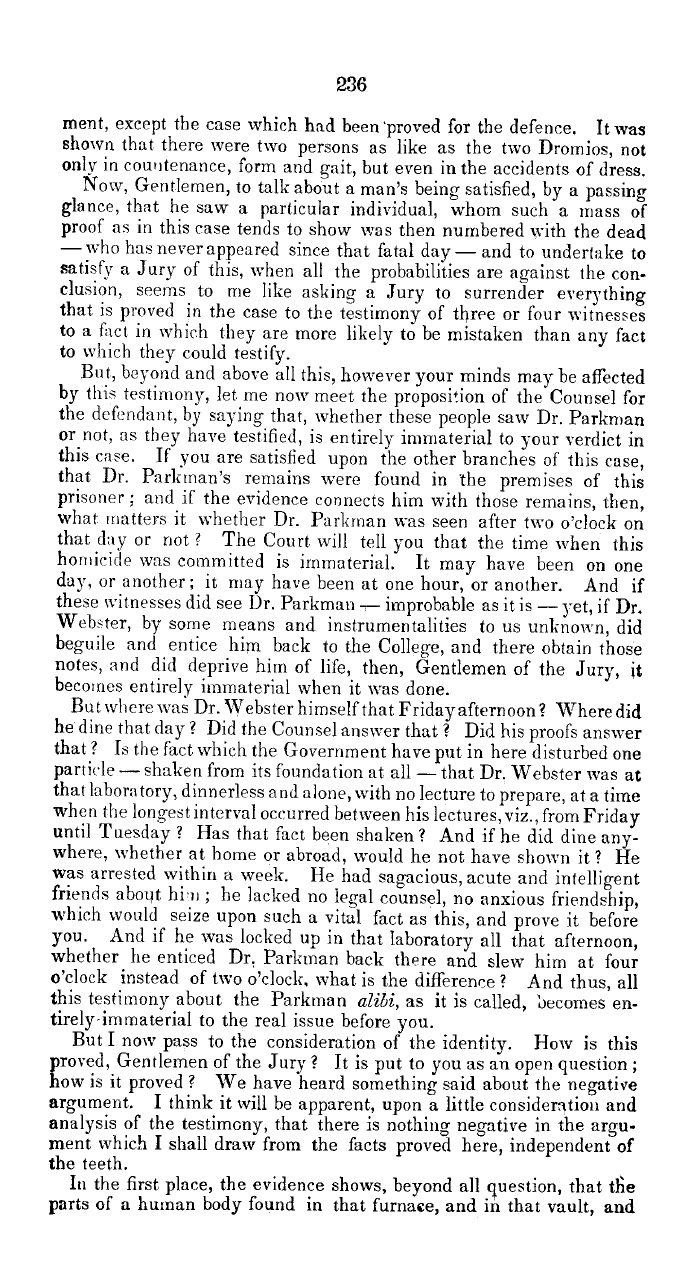|
236
ment, except the case which had been 'proved for the defence. It was
shown that there were two persons as like as the two Dromios, not
onlv in countenance, form and gait, but even in the accidents of dress.
Now, Gentlemen, to talk about a man's being satisfied, by a passing
glance, that he saw a particular individual, whom such a mass of
proof as in this case tends to show was then numbered with the dead
-who has never appeared since that fatal day-and to undertake to
satisfy a Jury of this, when all the probabilities are against the con-
clusion, seems to me like asking a Jury to surrender everything
that is proved in the case to the testimony of three or four witnesses
to a fact in which they are more likely to be mistaken than any fact
to which they could testify.
But, beyond and above all this, however your minds may be affected
by this testimony, let me now meet the proposition of the Counsel for
the defendant, by saying that, whether these people saw Dr. Parkman
or not, as they have testified, is entirely immaterial to your verdict in
this case. If you are satisfied upon the other branches of this case,
that Dr. Parkcnan's remains were found in the premises of this
prisoner ; and if the evidence connects him with those remains, then,
what matters it whether Dr. Parkrnan was seen after two o'clock on
that day or not ? The Court will tell you that the time when this
homicide was committed is immaterial. It may have been on one
day, or another; it may have been at one hour, or another. And if
these witnesses did see Dr. Parkman - improbable as it is - yet, if Dr.
Webster, by some means and instrumentalities to us unknown, did
beguile and entice him back to the College, and there obtain those
notes, and did deprive him of life, then, Gentlemen of the Jury, it
becomes entirely immaterial when it was done.
But wherewasDr.WebsterhimselfthatFridayafternoon? Wheredid
he dine that day ? Did the Counsel answer that? Did his proofs answer
that ? Is the fact which the Government have put in here disturbed one
particle-shaken from its foundation at all-that Dr. Webster was at
that laboratory, dinnerless and alone, with no lecture to prepare, at a time
when the longest interval occurred between his lectures, viz., from Friday
until Tuesday ? Has that fact been shaken ? And if he did dine any-
where, whether at home or abroad, would he not have shown it? He
was arrested within a week. He had sagacious, acute and intelligent
friends about hi ii ; he lacked no legal counsel, no anxious friendship,
which would seize upon such a vital fact as this, and prove it before
you. And if he was locked up in that laboratory all that afternoon,
whether he enticed Dr. Parkman back there and slew him at four
o'clock instead of two o'clock, what is the difference ? And thus, all
this testimony about the Parkman alibi, as it is called, becomes en-
tirely-immaterial to the real issue before you.
But I now pass to the consideration of the identity. How is this
proved, Gentlemen of the Jury? It is put to you as an open question ;
how is it proved ? We have heard something said about the negative
argument. I think it will be apparent, upon a little consideration and
analysis of the testimony, that there is nothing negative in the argu-
ment which I shall draw from the facts proved here, independent of
the teeth.
In the first place, the evidence shows, beyond all question, that tfie
parts of a human body found in that furnace, and in that vault, and
|

